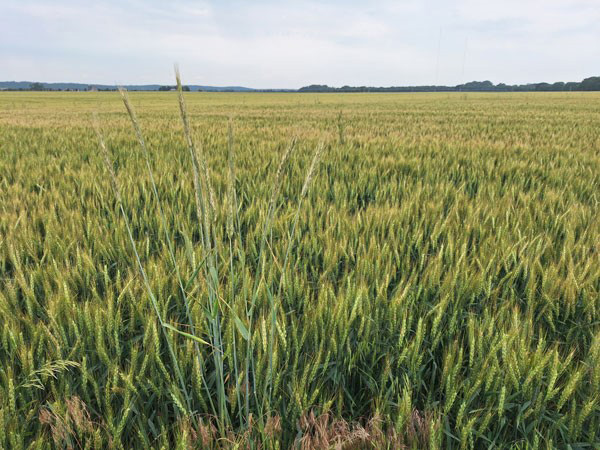Cereal rye can provide excellent weed suppression as a cover crop; however, it should be handled carefully. Cereal rye can be introduced into a wheat field (Figure 1) by contamination of harvest or seed conditioning equipment, dry fertilizer spreaders, or drills. Seeds and pollen can also be moved by wind or other natural means.
Cereal rye is very similar to wheat in terms of life cycle, growth requirements, and appearance. There are a few features that distinguish rye from wheat:
- Plant height: Cereal rye is generally taller than winter wheat.
- Seed heads: Rye seed heads are usually longer and thinner.
- Ligule: The ligule of cereal rye lacks the fringe of hairs that winter wheat has.
- Auricles: Cereal rye does not have prominent auricles, unlike winter wheat.
- Seed characteristics: Rye seeds are longer than wheat seeds and typically have a yellow or greenish shade, rather than red.
These differences can help with identifying cereal rye in the field.

Figure 1. Cereal rye growing in a wheat field. Photo by Sarah Lancaster, K-State Research and Extension.
Chemical control of cereal rye in wheat is limited to herbicide-tolerant varieties (discussed later in this article). Because there are few herbicide options in crops, preventing the introduction of cereal rye into wheat fields is critical. Cleaning equipment and planting weed-free seed are two important measures. Hand rouging has long been used to remove cereal rye from wheat prior to harvest. Crop rotation is also important for controlling cereal rye and other winter annual grass weeds. Cereal rye emerging during a fallow phase of the rotation can be controlled with glyphosate. If cereal rye is present in wheat stubble, atrazine can be used if the following crop will be corn or sorghum.
Herbicide-tolerant wheat varieties
Clearfield wheat varieties allow the use of Beyond (imazamox). Imazamox is more effective on other cool-season grass weeds and only provides suppression of cereal rye. If you choose a Clearfield variety, be sure to spray before rye tillers and use a nitrogen fertilizer (up to 50% of the spray solution). Two applications (4 fl oz in the fall and 4 fl oz in the spring) will provide better control than a single application. If a single application is used, apply Beyond at the maximum single-use rate of 6 fl oz. However, it is important to note that imazamox resistance has been confirmed in cereal rye from Colorado.
CoAXium wheat varieties allow the use of Aggressor (quizalofop). Quizalofop provides excellent control of cereal rye. In studies at Great Bend, control was 94% or greater with 10 or 12 fl oz of Aggressor applied with either NIS or MSO in fall or spring. Quizalofop is a Group 1 herbicide that only controls grasses.
In both systems, cereal rye control will be reduced if applications are made when temperatures are below 40°F during the week following application.
For more detailed information, see the “2025 Chemical Weed Control for Field Crops, Pastures, and Noncropland” guide available online at https://www.bookstore.ksre.ksu.edu/pubs/CHEMWEEDGUIDE.pdf or check with your local K-State Research and Extension office for a paper copy.
The use of trade names is for clarity to readers and does not imply endorsement of a particular product, nor does exclusion imply non-approval. Always consult the herbicide label for the most current use requirements. Users should read and follow all label directions.
Sarah Lancaster, Extension Weed Science Specialist
slancaster@ksu.edu
Patrick Geier, Weed Scientist
pgeier@ksu.edu
Jeremie Kouame, Weed Scientist
jkouame@ksu.edu
Tags: weeds weed control cereal rye